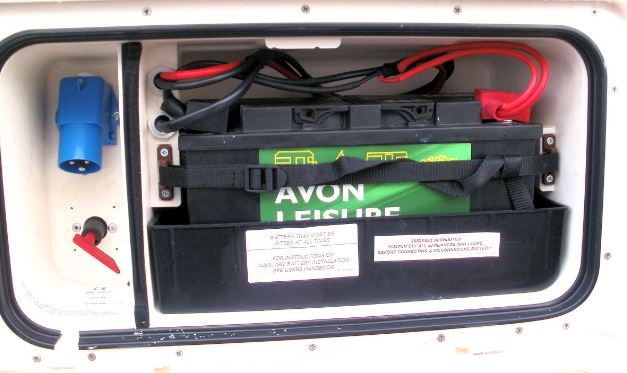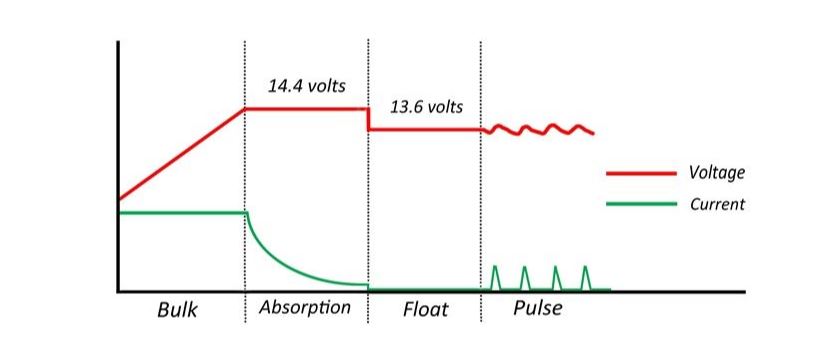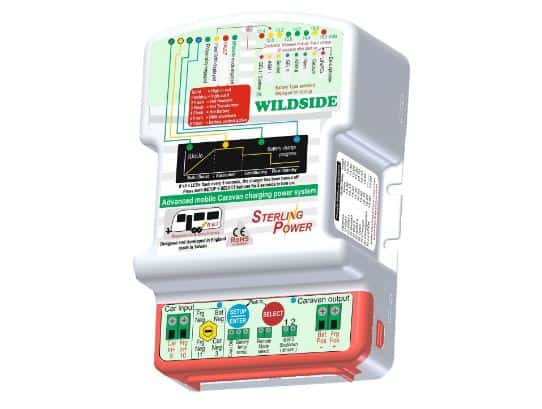
The leisure batteries in caravans or motorhomes perform a very important role. Whether you like to only use caravan sites with mains power or you go off-grid wild camping, you need your leisure battery to be performing well. You also need to think about winter. In the winter, you will likely be using your caravan or motorhome less or not at all. A portable battery charger for the leisure battery in your caravan or motorhome is an essential piece of kit.

A good quality leisure battery charger for your caravan or motorhome is an essential piece of kit: Image – Amazon.co.uk
Disclaimer: Hey! By the way… any links on this page that lead to products on Amazon or Caravan Guard are affiliate links, and I earn a commission if you make a purchase, with no additional cost to you 🙂
- Dissolves waste and removes odours naturally and has delightful mild fragrance
When I meet our guests, we often discuss various issues they have been having with their caravan or motorhome and how they addressed them.
Something that is very evident is if you have a caravan motor mover, you really want to keep your leisure battery in tip-top condition.
A good quality portable charger can assist with leisure battery maintenance and even recovery.
With this post, I’ll discuss the aftermarket built-in leisure battery charger options you could consider and portable leisure battery chargers. You can use the table of contents below to jump to a particular section:
Want To Visit Horton Common? – Book Here
Table of Contents
Onboard vs Portable Chargers
First, it’s probably a good idea to discuss the differences between the on-board battery charger in your caravan or motorhome and a portable leisure battery charger.
The video below from practical caravan provides a good brief overview of the differences.
To quickly summarise the points made in the video above, a built-in leisure battery charger provides a maximum power of 13.8V, whereas portable leisure battery chargers will potentially provide up to 15V of power.
Built-in leisure battery chargers have to provide power to the battery while 12V appliances are potentially in use.
Therefore, built-in chargers don’t provide an excessive amount of power which may damage those 12V appliances or lights.
Whereas a portable leisure battery charger can provide more power to the battery. However, they should only be used when the battery is isolated from the 12V appliances.
Quick Note: Recently, I also became aware of caravan fridge problems while towing related to battery charging from some Euro 6 engine vehicles.
Checking Your Leisure Batteries State of Charge
Before we discuss the various portable and built-in leisure battery options, we need to discuss how you actually check when your battery needs charging.
Most caravans and motorhomes have either an analogue or digital voltage meter as part of the master control panel.
However, you can also use a portable voltage meter to test the state of charge. The voltage reading the battery returns will indicate the state of charge.
| Battery Voltage | State of Charge |
|---|---|
| 12.6V or over | 100% |
| 12.5V | 80% |
| 12.1V | 50% |
| 11.7V | 25% |
| 11V or below | Empty |
Now, ideally, to get the most accurate reading on the leisure battery’s state of charge, you need to separate the battery completely from your caravan or motorhome.
The reason being, even if you believe all your 12V appliances are off, there may still be something pulling power.
For instance, security trackers do have their own small 12V batteries. However, when these batteries are empty or fail, they pull power from the main leisure battery.
Therefore, ideally, before you test the voltage and state of charge, you will isolate the battery.
Also, in an ideal world, you’ll want to check the state of charge once a month. You’ll also be removing the leisure battery and using a suitable portable battery charger around once every six weeks.
The most important points to remember are to not leave the leisure battery at a low state of charge as it can lead to damage.
In the winter months, particularly, a leisure battery at a very low state of charge can even freeze! If that does happen, the leisure battery could be permanently damaged.
Cycle Life and Deep Cycles
Depending on the type of technology used in the leisure battery, the number of cycles it can withstand before failure varies.
Furthermore, how deep the cycles typically are (how discharged the battery gets during use) will also dictate its usable life.
Again as previously referenced, my post on leisure batteries covers cycle life and deep cycles.
However, as a general rule, with the most common lead-acid leisure batteries, you don’t want to let it discharge below 50% as this will cause damage (sulphation).
Onboard Leisure Battery Chargers
Depending on how old your caravan or motorhome is, it will dictate how efficient and capable the onboard charger is at keeping your leisure battery in a healthy state of charge.
Some people don’t really regard the charger built-in to caravans and motorhomes as ‘true’ chargers, as they rarely will take a leisure battery to its full state of charge.
Typically older caravan and motorhome onboard built-in chargers will take the battery up to a maximum of 13.8V.
More modern ‘intelligent’ onboard built-in chargers will go higher, closer to 15V. Leisure battery technologies have advanced considerably over the last couple of decades.
Therefore if you install a modern gel or lithium battery into an old caravan or motorhome you’re probably not getting the best out of that battery.

Therefore it is regarded as good practice to periodically connect the leisure battery in your caravan or motorhome up to a portable battery charger designed specifically for caravans and motorhomes.
This will be able to take the battery up to its full state of charge and also indicate the condition of the battery.
Portable Caravan Leisure Battery Chargers
The first thing to mention with portable battery chargers, as referenced in the video above, is that different types of leisure batteries (standard lead-acid, AGM, Gel etc) prefer different rates of charge.
Always check the rate of charge recommended by the battery manufacturer.
If you’re considering purchasing a new leisure battery, you can read my post on the different leisure battery types and their pros and cons.

Different Types of Portable Leisure Battery Chargers
Depending on how much you are willing to spend, there are different types of technologies used in portable chargers for leisure batteries.
Purchasing the cheapest charger for your caravan or motorhome leisure battery may be a false economy as it could lead to overcharging and damaging the battery.
Open-cell lead acid leisure batteries are particularly vulnerable to overcharging, and it will lead to excessive ‘off-gassing’. If overcharging continues for an extended period of time, it can actually lead to what’s called ‘boiling dry’.
This is pretty much what it sounds like, where the water content of the battery’s electrolyte leaves the battery. The plates of the leisure battery are then exposed, potentially leading to irreparable damage.
It’s also worth noting that while gel and AGM leisure batteries are valve regulated (VRLA) and do not vent off-gases to the same extent as an open-cell lead-acid battery, they will vent in an overcharging situation.
Also, with a VRLA battery, it’s not possible to top them up with distilled water. Hence, the point is, overcharging any battery is a bad idea.
Unregulated Voltage Battery Chargers
The cheapest portable leisure battery charges are typically categorised as ‘unregulated’ chargers. Here the voltage can reach as high as 15V as the leisure battery reaches full charge.
Being unregulated, there is nothing to drop the voltage as the battery approaches full charge, potentially leading to damage.
So if you are going to go for basic unregulated battery chargers, you need to keep a close eye on the voltage of the battery and turn off the charger as soon as 12.6V (full charge) is achieved.
Semi-Automated Battery Chargers
The next step up from basic unregulated chargers is semi-automated products. This type of portable leisure battery charger monitors the state of charge.
Therefore, once the set voltage is achieved, a semi-automated battery charger will turn itself off.
Depending on the model and make, you may be able to set the turn-off voltage. For a standard open-cell leisure battery, the manufacturer may recommend charging up to 15V, for low-maintenance VRLA batteries (Gel and AGM), this may be lower at around 14V.
Again, you should check the manufacturer’s recommendation for whichever leisure battery you have fitted to your caravan or motorhome.
Fully Automated Leisure Battery Chargers
So the best and likely most expensive portable battery chargers for the leisure battery in your caravan or motorhome are fully automated products.
Fully automated chargers are also sometimes referred to as multi-stage chargers.
You can leave this type of charger permanently connected to your caravan or motorhome leisure battery without the risk of overcharging damage.
Fully automated multi-stage chargers start with three stages, with some products having up to 8 stages.
The first stage provides a constant current with a rising voltage up to the battery’s maximum state of charge (Bulk Stage).
Then the voltage remains constant while the current is steadily lowered (Aborbtion Stage).
In the next stage, the voltage is dropped slightly, and the current is held steady (Float Stage). Now some chargers also have a Pulse Stage (more details on that below).

The best fully automated chargers will monitor the temperature of the leisure battery in your caravan or motorhome. The charger will then adjust the charging rate accordingly.
For instance, using a lower current and voltage during colder conditions when the battery is more vulnerable to damage.
During warmer temperatures, the charger will feed higher currents and voltages to the limit the user sets depending on the type of leisure battery.
What is Pulse Charging?
During pulse charging, both the voltage and current are frequently raised and dropped. Pulse charging can provide a couple of benefits.
First, it can stop the self-discharge of the leisure battery. It can also help to prevent what is called stratification.
Stratification is where sulphuric acid, which is part of the electrolyte in the leisure battery, sits idle at the bottom of the battery. This leads to corrosion issues within the battery.
Pulse charging can effectively agitate the electrolyte to stop this separation from taking place. Along with pulse charging stages, some fully automated chargers also have stages referred to as soft-start and reconditioning modes.
Pulse Charging Combats Battery Sulphation
Sulphation occurs when lead sulphate forms on the battery plates during discharge.
Now, if you leave a lead-acid battery in a discharged state for several weeks or months, this can cause lead sulphate crystals to form on the leisure battery plates. This will reduce the capacity of the battery and its usable life.
The benefit of pulse charging a lead-acid battery is to destroy sulphate crystals which can aid in increasing usable battery life. Just to clarify, there are chargers with a pulse charging mode and pulse maintaining mode.
Some chargers only have one of these modes, other portable chargers have both. Pulse charging uses higher currents and voltages than the pulse maintenance mode.
When Would You Use a Portable Leisure Battery Charger?
The onboard built-in charger in your caravan or motorhome has its limits. Therefore, to take your leisure battery up to its full state of charge, you will need a portable charger.
Another scenario where you will need a portable battery charger is when your caravan is in storage during the winter months.
Some choose to have two leisure batteries which they alternate. They keep one at home, which they use a portable charger on while the second battery sits in the caravan.
If you have a security system and tracker, you will need to have a leisure battery in the caravan or motorhome at all times.
Not providing the security system with sufficient power can potentially invalidate your insurance if the vehicle was stolen.
Obviously, having to purchase a second leisure battery is an additional expense, also, swapping the leisure battery can be quite a faff.
Therefore some people choose to go down the route of using a caravan solar panel to trickle charge the leisure battery, the video below is a good example:
Best Portable Leisure Battery Chargers
Below are some examples of the best portable battery chargers. All of the products below can be used for leisure batteries in caravans and motorhomes.
AA 12V 1.2A – Semi-Automated Charger
This relatively cheap charger is suitable for both lead-acid and gel leisure batteries. While it has an ‘intelligent’ built-in microprocessor, it is not a true fully automated charger.
However, it does feature reverse polarity protection as well as short circuit protection.

As a relatively cheap option, the AA 12V 1.2A semi-automated charger is worth a consideration for your leisure battery: Image – Amazon.co.uk
It currently benefits from a 4.5 out of a 5-star review on Amazon from 599 reviews. However, at only 1.2A it’s going to take quite a while to get a leisure battery up to charge.
A typical 100Ah battery fitted in caravans and motorhomes in a low state will take around 100 hours.
Numax 12V 10A – Fully Automated Charger
Currently, quite a popular product on Amazon, the Numax 12V 10A leisure battery charger is promoted as ‘connect and forget’.
Therefore, referring to our discussion above on the different charger types, the Numax appears to be a fully automated charger.
With stated features such as Fast Cycle Charge, Deep Discharge Recovery and Battery Maintenance modes.

The Numax leisure battery charger appears to be quite a popular choice for caravans and motorhomes: Image – Amazon.co.uk
Reviewers on Amazon appear generally pretty happy with the charger’s performance. Some specifically note the Numax’s ability to recover batteries.
One review states the battery was recovered after it had been left idle for 2 years!
Numax recommends their 12V 10A charger is best used for leisure batteries between 50Ah and 135Ah. It comes with a standard 12-month warranty.
CTEK MXS 10 – Fully Automated Charger
So in line with the title of this post, I think the CTEK MXS 10 is the best portable battery charger you can currently get for your caravan or motorhome. It’s a fully automated 12V 10A charger.
If you do a bit of research, you’ll see that CTEK are a well-established brand in the battery charger world.
The MXS range is compatible with a wide range of different battery technologies and has dedicated reconditioning modes.

It’s pretty hard to argue against the CTEK MXS 10 not being the best portable battery charger currently available for leisure batteries: Image – Amazon.co.uk
CTEK claim that frequent use of the MXS 10 can extend a leisure battery’s life by up to three times. Also, unlike the other chargers shown above, the CTEK comes with a 2-year warranty.
Now, the CTEK MXS 10 is not the cheapest option, as you will see from the link above. However, they do also offer cheaper units using the same technology with either a 3.8, 5 or 7 amp output.
The CTEK offers the best technology, and its also supported by over 2,000 reviews at 5 stars. Hence it’s hard to argue that the CTEK MXS 10 is not the best charger for leisure batteries currently available.
Battery to Battery Chargers
So now we have covered portable battery chargers, its time to discuss battery-to-battery chargers.
Currently, while towing, your leisure battery will receive a very minimal charge. Really, the car will just maintain the state of charge in the battery. It will add very little, if any, additional charge.
If you want to upgrade the rate of charge, you will require a battery-to-battery charger.
You’ll also need some additional (thicker) cables which run from the car to the caravan battery-to-battery charger. More details in the video below:

A popular Battery to Battery charger is the BB1230 produced by Sterling Power Products (as seen in the video above): Image – Amazon.co.uk
Conclusions on the Best Leisure Battery Chargers
So, in conclusion, I would recommend going for the CTEK MXS range of portable chargers. If you can afford the 10 amp version, that will give you the fastest rate of charge. However, CTEK also offers lower-priced/lower-amperage units.
Whichever battery charger you use is important to follow the manufacturer’s instructions on the rate of charge.
Sometimes, motorhome leisure batteries are located within the living space. If that is the case, before charging, make sure the battery is vented properly for ‘off-gassing’.
I hope you found the above useful and that you learnt something new today about leisure battery chargers.
I also hope, at some point in the future, you consider a visit to use our fully serviced pitches here at Horton Common. 🙂
Want To Visit Horton Common? – Book Here


